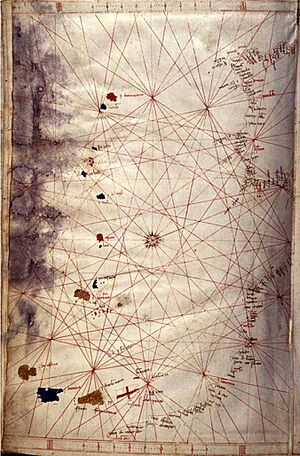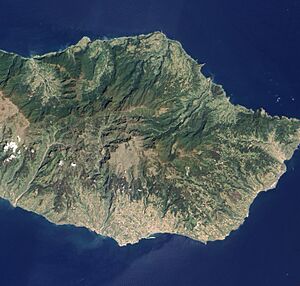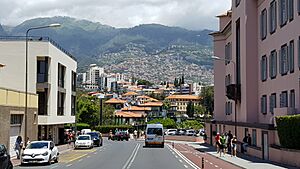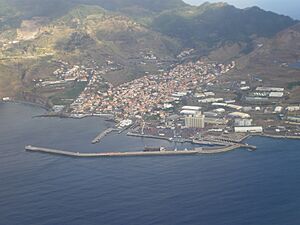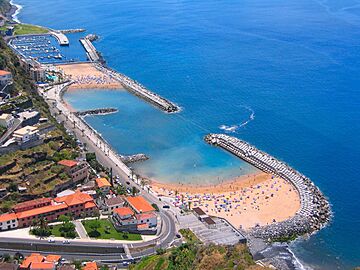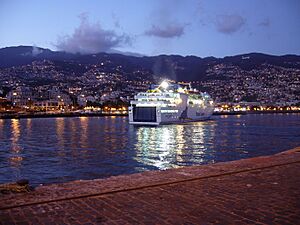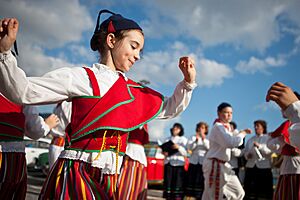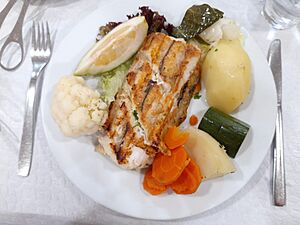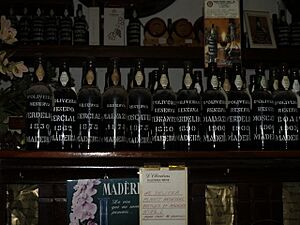Madeira facts for kids
Quick facts for kids
Madeira
|
|||
|---|---|---|---|
|
Autonomous Region of Portugal and outermost region of the European Union
|
|||
| Autonomous Region of Madeira Região Autónoma da Madeira (Portuguese) |
|||
|
|||
| Nickname(s):
Pearl of the Atlantic
|
|||
| Motto:
Das Ilhas as Mais Belas e Livres
(English: "Of all islands, the most beautiful and free") |
|||
| Anthem: Hino da Região Autónoma da Madeira (English: "Anthem of the Autonomous Region of Madeira") |
|||
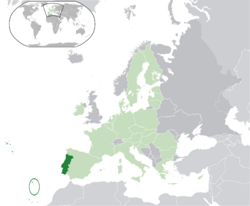
Location of Madeira within Portuguese territory (dark green) and the European Union (light green)
|
|||
| Country | |||
| Discovery | 1418–1419 | ||
| Settlement | c. 1425 | ||
| Autonomous status | 30 April 1976 | ||
| Named for | English: wood (Portuguese: madeira) | ||
| Capital
and largest city
|
Funchal 32°45′N 17°0′W / 32.750°N 17.000°W |
||
| Official languages | Portuguese | ||
| Demonym(s) | English: Madeiran (Portuguese: Madeirense) | ||
| Government | |||
|
• Representative of the Republic
|
Irineu Barreto | ||
|
• President of the Regional Government of Madeira
|
Miguel Albuquerque | ||
|
• President of the Legislative Assembly
|
José Manuel Rodrigues | ||
| Legislature | Legislative Assembly | ||
| National and European representation | |||
| 6 MPs (of 230) | |||
| 2 MEP (of 21 Portuguese seats) | |||
| Area | |||
|
• Total
|
801 km2 (309 sq mi) | ||
| Highest elevation | 1,861 m (6,106 ft) | ||
| Lowest elevation | 0 m (0 ft) | ||
| Population | |||
|
• 2021 census
|
250,769 | ||
|
• Density
|
313/km2 (810.7/sq mi) | ||
| GDP (nominal) | 2024 (Fitch) estimate | ||
|
• Per capita
|
|||
| Currency | Euro (€) (EUR) | ||
| Time zone | UTC±00:00 (WET) | ||
|
• Summer (DST)
|
UTC+01:00 (WEST) | ||
| Date format | dd/mm/yyyy (CE) | ||
| Driving side | right | ||
| Calling code | +351 (291) | ||
| Postal code |
90nn-94nn
|
||
| ISO 3166 code | PT-30 | ||
| Internet TLD | .pt | ||
| Usual abbreviation | RAM | ||
| Website | www.madeira.gov.pt | ||
Madeira is an autonomous region of Portugal. It is a group of islands, called an archipelago, located in the North Atlantic Ocean. Madeira is about 520 kilometers (323 miles) west of Morocco and 805 kilometers (500 miles) southwest of mainland Portugal.
Even though it sits on the African Tectonic Plate, Madeira is strongly connected to Europe in its culture, politics, and people. Most of its population are descendants of Portuguese settlers. In 2021, about 251,060 people lived there. The capital city is Funchal, located on the main island's south coast.
The Madeira archipelago includes the islands of Madeira, Porto Santo, and the Desertas. The Savage Islands are also part of this region. About half of the people live in Funchal. Madeira has its own government and rules, making it an integral part of the European Union. The climate is generally mild and subtropical, with dry summers and rainy winters. Different elevations on the islands create many unique microclimates.
Madeira was not inhabited when Portuguese sailors claimed it in 1419. Settlers arrived after 1420. This archipelago was the first land discovered during the Age of Discovery. Today, Madeira is a popular place for tourists all year round, especially for people from Portugal, Britain, and Germany. It is known for its Madeira wine, beautiful plants, and animals. Its ancient laurel forest is a UNESCO World Heritage Site. Funchal's harbor is a major stop for cruise ships traveling between Europe, the Caribbean, and North Africa. The International Business Centre of Madeira was also set up in the 1980s to attract businesses.
History of Madeira
Early Mentions and Legends
Some ancient writings, like those by Plutarch around 75 AD, mention ideal Atlantic islands. These might have been Madeira or nearby islands. There is also evidence that Vikings might have visited the islands between 900 and 1030.
An Arab writer, Muhammad al-Idrisi, wrote about sailors from Lisbon who found an island with many sheep. This island, possibly Madeira, must have been visited before for animals to be there.
A legend from the 14th century tells of two lovers, Robert Machim and Anna d'Arfet, who fled England. A storm blew their ship to an island, possibly Madeira. The city of Machico on the island is named after Robert Machim.
European Discovery
Madeira appeared on several old maps from the 14th century. These maps called it "Lecmane" or "Lolegname," meaning "the isle of wood." This suggests people knew about these islands before their official discovery by Portugal.
In 1418, two Portuguese captains, João Gonçalves Zarco and Tristão Vaz Teixeira, were exploring the African coast for Prince Henry the Navigator. A storm pushed their ship off course to an island. They named it Porto Santo, meaning "holy harbor," because they were saved from shipwreck.
The next year, Zarco, Vaz, and Bartolomeu Perestrello went back to Porto Santo. They claimed it for Portugal and started a settlement. From there, they saw a "heavy black cloud" to the southwest. When they investigated, they found a larger island. They called it Madeira, which means "wood" in Portuguese, because of its dense forests.

First Settlements and Growth
The first Portuguese settlers arrived on the islands around 1420 or 1425. These early settlers included the three captains and their families, some gentry, and ordinary people. Many were farmers and fishermen who hoped for a better life than in Portugal, which had suffered from the Black Death.
To farm the land, settlers had to cut down parts of the thick forests. They also built many water channels, called "levadas." These channels brought water from the rainy north side of the island to the drier south side for farming.
At first, settlers grew wheat for themselves and later exported it to Portugal. Over time, wheat production dropped. Prince Henry the Navigator then encouraged planting other crops to make the islands profitable.
Sugar cane became very important. The first water-powered sugar mill was built on Madeira. By 1455, sugar production grew significantly. Traders from Italy and Flanders came to Madeira to buy sugar, avoiding other trade routes. Funchal became a key port for European trade.
During the sugar trade period, some people used enslaved labor to work on the sugar cane fields alongside paid workers. These enslaved people came from the nearby Canary Islands, North Africa, and West Africa. However, only a small number of Madeirans owned slaves, and most owned only a few.
Madeira was a major sugar market in the Atlantic until the 16th century. The system of sugar production used here was later used on a much larger scale in other colonies like Brazil.
From Sugar to Wine
Madeira's sugar production eventually declined as larger plantations in Brazil and other Portuguese colonies took over. Sugar mills were abandoned, and the island shifted to other industries.
In the 17th century, Madeira wine became the island's most important product. Vineyards replaced sugar cane fields. This "Wine Culture" became famous worldwide and led to the rise of a new wealthy class.
English merchants settled on the island and began to control the wine trade. Madeira wine became very popular, even said to be used in a toast during the American Revolution by the Founding Fathers of the United States.
In the 18th and 19th centuries, Madeira became known for its climate and health benefits. Wealthy visitors, including patients, travelers, and scientists, came to the island. The first tourist guide for Madeira was published in 1850. The famous Belmond Reid's Palace hotel opened in 1891 and is still open today.
The British occupied Madeira twice, first in 1801 and again from 1807 to 1814, during the Peninsular War.
World War I Attacks
During World War I, German submarines attacked Funchal harbor. On December 3, 1916, a German U-boat sank three ships in the harbor. These included a British cable-laying vessel, a French transport ship, and a French gunboat. The U-boat then shelled Funchal for two hours. Madeiran batteries fired back, forcing the submarine to leave.
On December 12, 1917, two more German U-boats attacked Funchal again. They fired 40 shells, causing three deaths and 17 injuries. Several houses and a church were hit.
After the war, the last Austrian Emperor, Charles I, was sent into exile in Madeira. He died there on April 1, 1922. His coffin is in a chapel at the Church of Our Lady of Monte.
Geography of Madeira
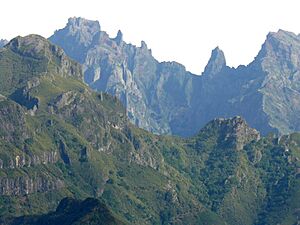
The Madeira archipelago is located about 520 kilometers (323 miles) from the African coast. It is 805 kilometers (500 miles) from the closest point in Europe, and 1000 kilometers (621 miles) from Lisbon, Portugal's capital.
Islands and Islets
The Madeira archipelago includes several islands and smaller islets:
- Madeira: The largest island, covering about 740.7 square kilometers (286 square miles). It includes smaller islets like Ilhéu de Agostinho. Its population was 262,456 in 2011.
- Porto Santo: About 42.5 square kilometers (16.4 square miles). It includes several islets like Ilhéu de Baixo. Its population was 5,483 in 2011.
- Desertas Islands: Three uninhabited islands covering about 14.2 square kilometers (5.5 square miles). These are Deserta Grande Island, Bugio Island, and Ilhéu de Chão.
- Savage Islands: An archipelago located 280 kilometers (174 miles) south-southeast of Madeira Island. It includes three main uninhabited islands and 16 smaller islets.
Tallest Peaks
Madeira's mountains offer amazing views. Here are the ten tallest peaks on the island:
| Rank | Peak Name | m | ft |
|---|---|---|---|
| 1. | Pico Ruivo | 1862 | 6109 |
| 2. | Pico das Torres | 1847 | 6060 |
| 3. | Pico do Areeiro | 1818 | 5965 |
| 4. | Pico do Cidrão | 1801 | 5909 |
| 5. | Pico do Gato | 1780 | 5840 |
| 6. | Pico Grande | 1655 | 5430 |
| 7. | Pico Ruivo do Paul da Serra | 1649 | 5410 |
| 8. | Queimadas | 1500 | 4921 |
| 9. | Pico do Serradinho | 1436 | 4711 |
| 10. | Chao dos Terreiros | 1436 | 4711 |
Madeira Island Formation
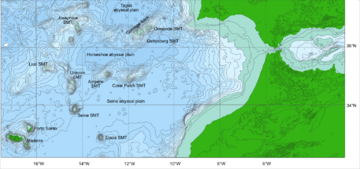
Madeira island is the top of a huge shield volcano. This volcano rises about 6 kilometers (3.7 miles) from the Atlantic Ocean floor. It formed over millions of years, starting about 5 million years ago. After the volcano formed, it was shaped by a lot of erosion, creating large valleys that open to the south.
Later, more volcanic activity added new cones and lava flows. The most recent eruptions happened about 6,500 years ago.
Madeira is the largest island in the group, covering 741 square kilometers (286 square miles). It is about 57 kilometers (35 miles) long and 22 kilometers (14 miles) wide. A mountain ridge runs along the center of the island. Its highest point is Pico Ruivo at 1,862 meters (6,109 feet). Steep sea cliffs, like Cabo Girão, and deep valleys extend from this central ridge. This makes the island's interior difficult to access. Most people live in villages along the coast, where rivers flow into the sea.
Climate
Madeira has many different climates depending on the location. Factors like sun exposure, humidity, and temperature create clear differences between the north and south sides of the islands. The islands are affected by the Gulf Stream and Canary Current, which give them mild to warm temperatures all year.
In Funchal, the average yearly temperature is about 19.6°C (67.3°F). Mountains greatly affect rainfall; some areas, like the Madeira Natural Park, can get a lot of rain each year. Madeira has lush laurel forests, while Porto Santo, a flatter island, has a drier climate. Snowfall can occur in the mountains during winter.
| Climate data for Funchal, capital of Madeira | |||||||||||||
|---|---|---|---|---|---|---|---|---|---|---|---|---|---|
| Month | Jan | Feb | Mar | Apr | May | Jun | Jul | Aug | Sep | Oct | Nov | Dec | Year |
| Record high °C (°F) | 25.5 (77.9) |
27.0 (80.6) |
30.5 (86.9) |
32.6 (90.7) |
34.2 (93.6) |
38.7 (101.7) |
37.7 (99.9) |
38.5 (101.3) |
38.4 (101.1) |
34.1 (93.4) |
29.5 (85.1) |
26.5 (79.7) |
38.7 (101.7) |
| Mean daily maximum °C (°F) | 19.7 (67.5) |
19.7 (67.5) |
20.4 (68.7) |
20.6 (69.1) |
21.6 (70.9) |
23.4 (74.1) |
25.1 (77.2) |
26.4 (79.5) |
26.4 (79.5) |
24.9 (76.8) |
22.6 (72.7) |
20.7 (69.3) |
22.6 (72.7) |
| Daily mean °C (°F) | 16.7 (62.1) |
16.6 (61.9) |
17.2 (63.0) |
17.5 (63.5) |
18.6 (65.5) |
20.6 (69.1) |
22.2 (72.0) |
23.2 (73.8) |
23.2 (73.8) |
21.8 (71.2) |
19.6 (67.3) |
17.9 (64.2) |
19.6 (67.3) |
| Mean daily minimum °C (°F) | 13.7 (56.7) |
13.4 (56.1) |
13.9 (57.0) |
14.4 (57.9) |
15.6 (60.1) |
17.7 (63.9) |
19.2 (66.6) |
20.0 (68.0) |
20.0 (68.0) |
18.6 (65.5) |
16.6 (61.9) |
15.0 (59.0) |
16.5 (61.7) |
| Record low °C (°F) | 8.2 (46.8) |
7.4 (45.3) |
7.7 (45.9) |
9.3 (48.7) |
9.7 (49.5) |
12.0 (53.6) |
14.6 (58.3) |
16.3 (61.3) |
14.9 (58.8) |
13.1 (55.6) |
9.8 (49.6) |
8.0 (46.4) |
7.4 (45.3) |
| Average precipitation mm (inches) | 74.1 (2.92) |
83.0 (3.27) |
60.2 (2.37) |
44.0 (1.73) |
28.9 (1.14) |
7.2 (0.28) |
1.6 (0.06) |
2.0 (0.08) |
32.9 (1.30) |
89.5 (3.52) |
88.8 (3.50) |
115.0 (4.53) |
627.2 (24.69) |
| Average precipitation days (≥ 0.1 mm) | 12 | 10 | 9 | 8 | 6 | 3 | 1 | 2 | 6 | 9 | 10 | 13 | 87 |
| Average relative humidity (%) | 71 | 70 | 68 | 68 | 70 | 73 | 73 | 72 | 71 | 71 | 70 | 70 | 71 |
| Mean monthly sunshine hours | 160.9 | 166.8 | 197.7 | 194.8 | 208.6 | 194.0 | 232.5 | 236.7 | 210.8 | 194.3 | 165.9 | 151.1 | 2,314.1 |
| Percent possible sunshine | 50 | 54 | 53 | 50 | 48 | 45 | 55 | 57 | 57 | 55 | 53 | 49 | 52 |
| Source 1: Instituto Português do Mar e da Atmosfera | |||||||||||||
| Source 2: NOAA (humidity and some records 1961–1990) German Meteorological Service (sunshine 1991-2020) | |||||||||||||
Flora and Fauna of Madeira
Madeira is home to many unique plants and animals found nowhere else. The original subtropical rainforest that once covered the island was largely cleared for farming. However, in the north, deep valleys still protect native trees. These ancient laurissilva forests are a UNESCO World Heritage Site. They have existed for at least 1.8 million years.
Some critically endangered plant species, like the vine Jasminum azoricum and the rowan Sorbus maderensis, are found only here. The Madeiran large white butterfly was a unique type of large white butterfly that lived in these forests. Sadly, it has not been seen since 1977.
Madeiran Wall Lizard
Madeiran Wolf Spider
The Hogna ingens, also known as the Deserta Grande wolf spider, lives only on Deserta Grande Island in the Madeira archipelago. It is critically endangered and is considered the largest spider in its family. Efforts are being made to protect it.
Birds of Madeira
Three bird species are found only in Madeira: the Trocaz pigeon, the Madeira Chaffinch, and the Madeira firecrest. Several other bird species that once lived here are now extinct. These include the Madeiran scops owl and two types of rail and quail. The Madeiran wood pigeon, a type of common wood pigeon, was last seen in the early 20th century.
Mice of Madeira
Madeira is home to six types of brown mice. Scientists believe they are descendants of common European brown mice brought by Vikings in the 9th century or by Portuguese settlers in the 15th century. These mice have changed so much that they cannot breed with their ancestors or with each other. They have the same genes but different numbers of chromosomes. The deep valleys on Madeira keep the different mouse species separated.
Levadas
Population and Diaspora
Demographics
Madeiran Diaspora
Many Madeirans have moved to other countries over the years. Large communities can be found in the United States, Venezuela, Brazil, Guyana, South Africa, and Trinidad and Tobago. In North America, Madeiran immigrants often settled in places like New England, Toronto, and Hawaii. The city of New Bedford in the US has a rich Madeiran heritage and hosts the Museum of Madeira Heritage.
The annual Feast of the Blessed Sacrament in New Bedford is the world's largest celebration of Madeiran heritage. It attracts tens of thousands of people.
During a famine in 1846, over 6,000 Madeirans moved to British Guiana. By 1902, about 5,000 Portuguese people, mostly Madeirans, lived in Honolulu, Hawaii. This number grew to 21,000 by 1910.
In 1849, some Protestant Madeirans, who faced discrimination for their religion, moved to the United States. They settled in Illinois with help from the American Protestant Society. These families had first moved to Trinidad and other parts of the West Indies for work.
Large Madeiran communities also exist in the UK and Jersey. The Portuguese British community, mostly Madeirans, celebrates Madeira Day.
In Venezuela, Madeiran Portuguese settled in cities like Caracas. Many became involved in commerce, founding supermarkets and bakeries. A state in Venezuela, Portuguesa, was named after its large Portuguese population.
Immigration to Madeira
Madeira is part of the Schengen Area, which allows free movement between many European countries.
Madeira's population has grown due to its popularity. In 2022, the population reached 253,259. The number of foreign residents has also increased. As of December 31, 2022, there were 11,793 immigrants, a 13.3% increase from 2021. The main foreign communities are from Venezuela, the United Kingdom, Germany, and Brazil.
Economy of Madeira
Madeira's economy is growing. In 2018, its economic output was 4.9 billion euros, which was 2.4% of Portugal's total. The average income per person was 22,500 euros.
Madeira has also embraced Bitcoin. The regional government has policies that exempt Bitcoin investors from paying personal income taxes. The President of the Regional Government confirmed the opening of a business hub focused on Bitcoin and new technologies. This move aims to boost technological progress and international partnerships.
Madeira International Business Center
The International Business Centre of Madeira (MIBC) is a special free trade zone. It helps create new businesses and services for small and medium-sized industries. The MIBC has three main areas: the Industrial Free Trade Zone, the International Shipping Register, and International Services.
Madeira's tax rules for the MIBC have been approved by the European Commission. This means they are legal and will continue until 2027. The MIBC was created in the 1980s to attract investment to Madeira.
The MIBC operates under Portuguese and EU laws. It is regulated by authorities, making it a transparent and stable place for business. It is not a "tax haven." This program has helped create skilled jobs and brought professionals back to Madeira. It has also increased business tourism and helped other sectors like real estate and telecommunications. Companies in the MIBC contribute over 40% of the corporate income tax for Madeira's government and create nearly 3,000 jobs. Salaries in these jobs are higher than average.
Tourism in Madeira
Tourism is a very important part of Madeira's economy. It contributes 20% to the region's total economic output. Tourism supports many other businesses, like shops and transportation, all year round. It also creates a market for local products. The island of Porto Santo, with its 9-kilometer (5.6-mile) long beach, is entirely focused on tourism.
Most visitors come from Europe, especially from Portugal, Britain, Germany, and France. In 2008, the average hotel occupancy rate was 60.3%, reaching over 70% in March and April.
Whale Watching
Whale watching has become very popular in Madeira. Many types of dolphins and whales can be seen near the coast or offshore. These include common dolphins, bottlenose dolphins, and various whale species like Bryde's whale and sperm whale.
Sustainable Development
Madeira gets its electricity from EEM (Empresa de Electricidade da Madeira, SA). Most of the electricity comes from fossil fuels. However, a significant amount comes from seasonal hydroelectricity, wind power, and a small amount of solar energy. The Ribeira dos Soccoridos hydropower plant uses a pumped hydropower reservoir to reuse mountain water during dry summers.
New battery technologies are being tested to reduce Madeira's need for imported fossil fuels. For example, a project on Porto Santo aims to replace fossil fuels entirely with renewable energy using a large battery. Madeira also uses a 15 MW lithium iron phosphate battery.
In the first half of 2022, 33% of Madeira's electricity came from renewable energy. This was achieved with help from the European Union.
A key part of this success is the centuries-old stone channels called levadas. These channels, built starting in the 15th century, stretch for thousands of kilometers. They efficiently carry rainwater from the northern regions to the south. This water is used for drinking, agriculture, and producing electricity.
The Socorridos hydroelectric power station is the island's main water system. It provides consistent power all year. A large EU-funded project improved water storage capacity. This included building a 5.4-kilometer (3.4-mile) tunnel and other mountain tunnels, which were big engineering challenges.
Wind power helps the system by moving stored water uphill when electricity demand is high. The treated water serves both people and farms, while also being a source of renewable energy. This project has helped local farmers with water issues and received awards for being one of the best EU-funded projects.
Transport in Madeira
The islands have two airports: Cristiano Ronaldo International Airport on Madeira and Porto Santo Airport on Porto Santo. The most frequent flights from Cristiano Ronaldo International Airport go to Lisbon. There are also direct flights to over 30 other airports in Europe and nearby islands.
You can travel between the two main islands by plane or by ferries from the Porto Santo Line. These ferries can also carry vehicles. Exploring the interior of the islands is now easy thanks to the "Vias Rápidas," which are major roads that cross the island. Modern roads reach all important places on the islands.
Funchal has a good public transportation system. Bus companies, like Horários do Funchal, have regular routes to all points of interest on the island.
Culture of Madeira
Music of Madeira
Folklore music is very popular in Madeira. It often uses local musical instruments like the machete, rajão, brinquinho, and cavaquinho. These instruments are used in traditional folk dances such as the bailinho da Madeira.
Madeiran emigrants also helped create new musical instruments. In the 1880s, the ukulele was developed based on two small guitar-like instruments from Madeira: the cavaquinho and the rajão. Portuguese immigrants from Madeira brought the ukulele to the Hawaiian Islands. Three cabinet makers from Madeira, Manuel Nunes, José do Espírito Santo, and Augusto Dias, are usually given credit for making the first ukuleles.
Cuisine of Madeira
Because Madeira is in the Atlantic Ocean, the island has many kinds of fish. The most commonly eaten species include black scabbardfish (espada), bluefin tuna, swordfish, and wahoo. Espada is often fried with a batter and served with fried banana (Espada com banana) or a passionfruit sauce. Bacalhau (salted codfish) is also popular, just like in mainland Portugal.
Madeira has many meat dishes. One of the most popular is espetada. This dish is traditionally made with large pieces of beef rubbed with garlic, salt, and bay leaf. The meat is marinated for several hours in Madeira wine, red wine vinegar, and olive oil. Then, it's skewered onto a bay laurel stick and grilled over wood chips. Special iron stands are used to hold the long skewers. Espetada is usually served with a local bread called bolo do caco.
A traditional holiday dish is "Carne de Vinho e Alhos." This dish is made from pork marinated for three days in white wine, vinegar, salt, and pepper. It is then cooked with small potatoes, sliced carrots, and turnip. Another common meat dish is "Picado," which is cubed beef cooked in a mushroom sauce and served with fries.
Other popular Madeiran dishes include açorda (a bread soup) and feijoada (a bean stew).
Traditional Madeiran pastries often use local ingredients like mel de cana, which is sugarcane honey (molasses). The traditional cake of Madeira is called Bolo de Mel, or "Sugarcane Honey Cake." By custom, it is never cut with a knife but broken into pieces by hand. It is a rich and heavy cake. The cake known as "Madeira cake" in England is named after Madeira wine.
Malasadas are a local sweet pastry mainly eaten during the Carnival of Madeira. Pastéis de nata, a type of custard tart, are also very popular, like in the rest of Portugal.
Milho frito is a popular Madeiran dish similar to Italian fried polenta. Açorda Madeirense is another local favorite.
Madeira is known for its high-quality cherimoya fruits. The Annona Festival is held every year in Faial to celebrate this fruit. The festival encourages people to eat cherimoya and its products, such as liqueurs, puddings, ice cream, and smoothies.
Beverages of Madeira
Madeira is a fortified wine made in the Madeira Islands. It can be sweet or dry. Its history goes back to the Age of Exploration, when Madeira was a common stop for ships traveling to the New World or East Indies. To keep the wine from spoiling, alcohol was added. However, winemakers discovered that the wine's flavor improved after being exposed to heat and movement during long sea voyages. Today, Madeira wine is known for its special process that involves heating the wine and allowing some oxidation. Most countries only allow wines from the Madeira Islands to be called "Madeira."
A local beer called Coral is made by the Madeira Brewery, which started in 1872. It has won many international awards. Other alcoholic drinks popular in Madeira include the local Poncha, Niquita, Pé de Cabra, and Aniz. Portuguese drinks like Macieira Brandy and Licor Beirão are also enjoyed.
Laranjada is a carbonated soft drink with an orange flavor. Its name comes from the Portuguese word laranja ("orange"). Launched in 1872, it was the first soft drink made in Portugal and is still very popular today. Brisa drinks, another popular brand, come in various flavors.
Madeira also has a strong coffee culture.
Sports in Madeira
Football is the most popular sport in Madeira. The island was the first place in Portugal to host an organized football match, played by British residents in 1875. Madeira is the birthplace of international football star Cristiano Ronaldo. It is also home to two well-known football teams, C.S. Marítimo and C.D. Nacional.
Besides football, Madeira has professional sports teams in basketball (CAB Madeira) and handball (Madeira Andebol SAD). The handball team was a runner-up in the 2019 European Challenge Cup. Madeira also hosted the 2003 World Men's Handball Championship.
The Rally Vinho da Madeira is an annual car rally race held since 1959. It is considered one of the biggest sporting events on the island.
Other popular sports activities include golf (at one of the island's two courses, plus one on Porto Santo), surfing, scuba diving, and hiking.
Sister Provinces
Madeira Island has friendly relationships with other regions around the world, called sister provinces:
 Aosta Valley, Italy (since 1987)
Aosta Valley, Italy (since 1987) Jersey (since 1998)
Jersey (since 1998) Eastern Cape, South Africa
Eastern Cape, South Africa Jeju Province, South Korea (since 2007)
Jeju Province, South Korea (since 2007) Gibraltar (since 2009)
Gibraltar (since 2009)
Postage Stamps
Portugal has issued postage stamps specifically for Madeira at different times, starting in 1868.
Images for kids
-
Many Portuguese immigrants in Hawaii were of Madeiran origin.
See also
 In Spanish: Madeira para niños
In Spanish: Madeira para niños




